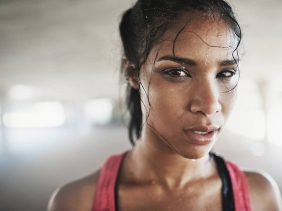High-Protein Vegan Foods for Your Plant-Based Lifestyle
 ©foodspring
©foodspring
High-protein diets are often used as a one-size-fits-all solution to any nutrition issue in the fitness industry – even for vegans. But how much protein do you really need? What are some high-protein vegan foods? And is lots of protein always healthy?
Protein shakes are just as common in the gym as leg press machines and pull-up bars. If you ask a trainer what kind of nutrition plan is better for losing weight or building muscle, you’ll often hear this answer: definitely more protein, then less of this or that other thing.
In principle, that’s right. Your body needs protein to build muscle, and eating it also helps maintain muscle mass while you’re in a calorie deficit. Nevertheless, protein is only one component of a healthy and balanced diet.
If you’re thinking about switching to a plant-based lifestyle, you’ve probably realized that eating vegan is much more than just cutting out meat, fish and dairy. Find out more about which nutrients are really important while we bust some myths about veganism here.
What is a High-Protein Diet?
There is no clear-cut definition of a high-protein diet. In the broadest sense, the term “high-protein” just means a large amount of your total calorie intake comes from protein.
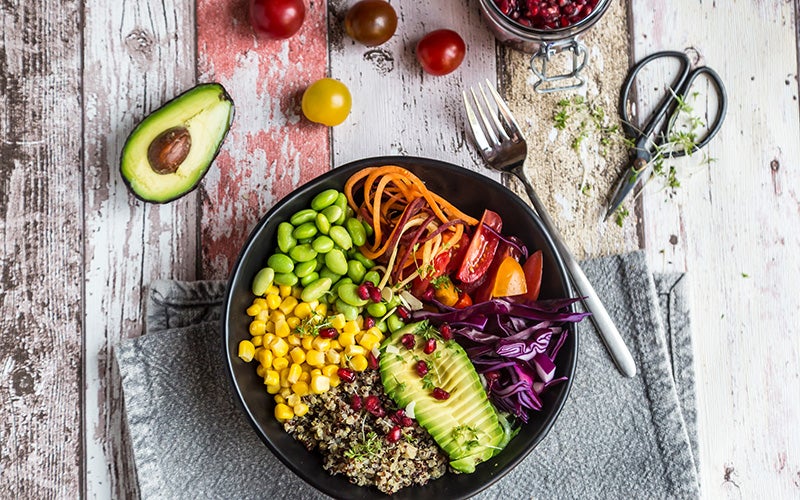
How much that is or should be is a matter of perspective: a nutrition plan that’s high in protein for a bodybuilder isn’t going to look the same as a plan for a hobby runner who sits in an office the rest of the day.
How much protein you need and what kind of vegan nutrition plan makes sense for you depends on your health, lifestyle, and goals.
How Much Protein Per Day Should I Eat?
The British Nutrition Foundation recommends eating 0.75 grams of protein per kilo of body weight per day. If you work out a lot, you can also aim for 1-1.2 grams of protein per kilo.
Normally, you can cover your protein needs with a variety of vegan foods as part of a balanced plant-based diet. Don’t have enough time to cook between the office, gym, and social life? We’ve got you covered! Our new Extra Layered Vegan Protein Bar makes it easy to meet your requirements in a way that’s quick AND tasty.
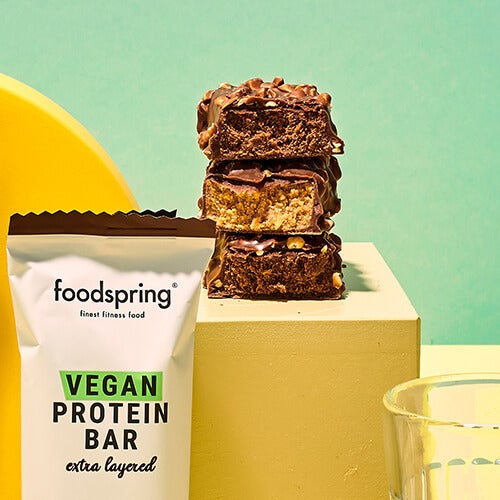
Check out our brand new Vegan Protein Bars
To make sure you get enough vitamins, minerals, trace elements and, above all, energy, your diet should be as varied and balanced as possible. Start making your nutrition plan by calculating all of your macronutrients as based on your total calorie requirements. Use the diagram below as a guide. This breakdown is based on general requirements to maintain your weight and a healthy lifestyle.
- 50 – 55 % Carbs
- 20 – 25 % Protein
- 20 – 30 % Fat
The perfect distribution of macros for you will always depend on your metabolism, your lifestyle, and your fitness plan. Competitive athletes, bodybuilders, and those following a nutrition plan with a large calorie deficit may have higher protein needs. If that sounds like you, take a look at our Body Check to find out how much protein makes sense for you and your goals.
High-Protein Nutrition Plans for Weight Loss
Want to shed a few pounds or get serious about reaching your feel-good weight? Nutrition plans full of vegan sources of protein are a great choice for weight loss because protein helps maintain muscle mass. If you eat too little, your muscles are broken down, because, in simple terms, your body can convert some protein components into energy more easily than fat.
To lose weight on a high-protein diet, it’s best to aim for a daily protein intake of 1.2-1.4 grams per kilo of body weight. Create a balanced nutrition plan incorporating this recommendation and you’re on your way.
High-quality protein shakes are a great addition to your nutrition plan – but just drinking shakes isn’t enough.

Sound complicated? That’s because it is! So we did a lot of the work for you and put together a 12-Week Shape Guide.
In the guide we’ve laid out plans for three months of perfectly balanced nutrition and training. With healthy and simple recipes for every day, including vegan options and a practical shopping list. Plus lots of in-depth knowledge and tips on nutrition and training.
High-Protein Plan for Building Muscle
Muscle building goes hand in hand with protein because that’s what muscles are largely made of. If you want your body to build new muscles, you have to provide it with the right building blocks. As a guideline, 1.2-1.4 grams of protein per kilo of body weight is also recommended for this nutrition plan.
The basic building block for your muscles is protein, or more precisely: amino acids. A nutrition plan for muscle building should provide your body with a balanced mix of different amino acids and all the minerals and vitamins you need. That way you’ve given your muscles everything they need for regeneration and muscle building after an intensive workout.
It’s best to divide up your protein evenly throughout the day: 20 g with each of your 3 main meals makes 60 g. With 2 snacks between those, you should be able to cover your protein needs easily. On training days, a post-workout shake is usually a good idea as well.
By the way, not all vegan protein shakes are the same: Plant-based proteins all have different amino acid profiles and we’ve carefully combined them in ours to make sure you get an optimal mix – without soy or gluten!
Reality Check: How Much Protein Are You Actually Eating?
Diets with plenty of sources of protein are relative luxuries in comparison to most of human history, but now they’ve become the standard in Western countries. The typical omnivore diet, meaning someone who eats meat, fish, cheese, and eggs, in addition to plants, often has more than enough protein. Vegan diets don’t have the same variety of protein sources, but they can reach similar levels of protein consumption with the right plan.
Meat and meat products still top the charts as the most common source of protein in the UK, but when averaged out across the whole population, a third of all protein consumed comes from plant-based protein sources. On average, men in the UK eat 88 grams of protein while women only eat 64.
Measure Your Protein Intake
Before you think about changing anything, take a moment to check how many grams of protein you’re getting now. Ask yourself the following questions:
- How many times a day do you eat protein-rich vegan foods, like legumes, nuts, or soy products? If you haven’t gone vegan yet, how often do you eat animal products?
- How often do you use supplements like protein shakes, amino acids, and protein bars?
- What other grains and vegetables do you put on your plate? And how much protein do those ingredients have?
Now keep a food diary for 7 days or enter your meals into an app that calculates everything automatically. Use this overview to check if you should be eating more protein per day and where it would be easy to add in another source of protein. It also makes it easier to figure out where you’ll need to pay attention to protein if you’re going vegan!
You may also find out that everything is already fine the way it is. Then the final thing to check is if your protein intake is evenly distributed throughout the day. The distribution is especially important if you’re consuming a lot of it!
What are some good vegan protein sources?
Most foods contain some protein, which is why it’s still possible to follow a high-protein diet without any animal products. The variety of vegan prepared meals and other products has only made it easier to get all the protein you need to make it through Veganuary and beyond.
Good sources of vegan protein include legumes and soy products. Many nuts, cereals (like quinoa) and seeds also contain significant amounts.
All foods have slightly different amino acid profiles and nutrient composition. You might have heard that getting a so-called complete protein – one that includes all nine amino acids that aren’t produced by the human body – is more difficult as a vegan. Thankfully there are a few plants that do have these amino acids, including buckwheat, quinoa, and chia seeds. It’s also possible to get a complete protein by combining various foods, like beans and rice or hummus and pita bread.
7 Recipes for Your High-Protein Nutrition Plan
A high-protein vegan diet doesn’t have to be complicated. In our recipe database, you’ll find a bunch of colorful recipe ideas for every taste and goal.
Here are our favorite vegan recipes that are also good sources of protein: easy to prepare, healthy, varied, and, most importantly, super delicious.
Vegan Hangover Green Smoothie
The perfect start to the day after a long night. This hydrating pick-me-up is done in 10 minutes and, with its chia seeds and 20 grams of protein per serving, it’s also the perfect partner for your muscle building plans.
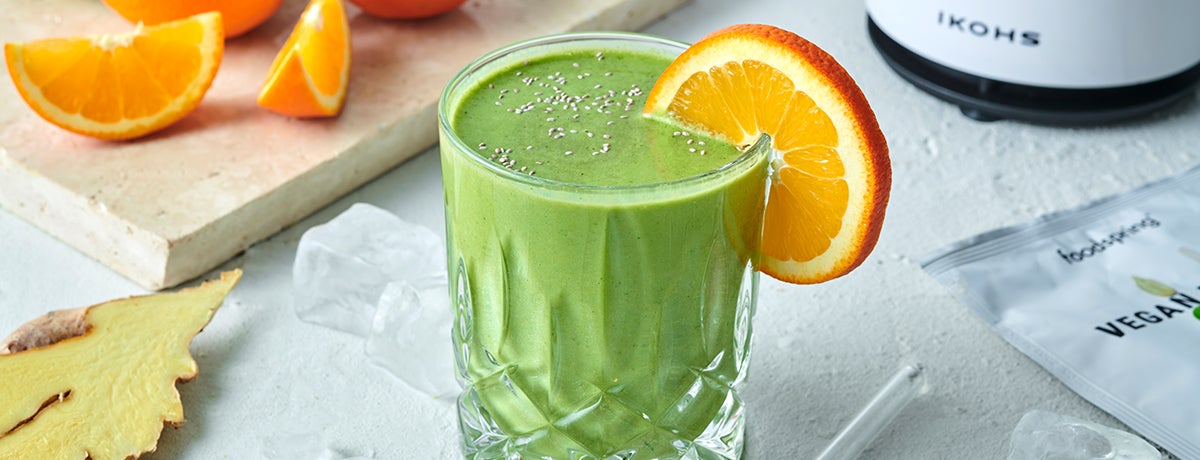
Spicy Vegan Peanut Stew
Need something to keep you going on a cold winter’s day? Veganuary is much easier with a spicy stew in your belly! In just over 30 minutes, you’ve got a protein-packed and comforting meal with this savory peanut stew. Substitute quinoa for the rice and you’ve added a complete protein to keep your plant-based diet balanced.
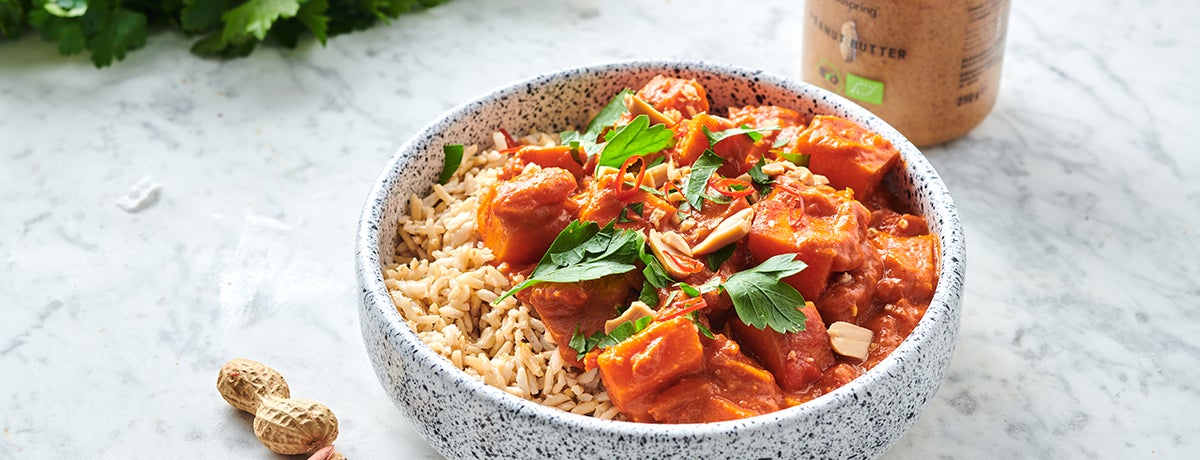
Zoodles with Lentil Bolognese
This dish is packed with nutrition because the noodles are made out of zucchini instead of pasta! Add lentils for protein and our vegan alternative to parmesan to make it a surprisingly similar substitute for the classic.

Matcha Nice Cream
The perfect vegan dessert for a sweet snack in the afternoon or at the end of the day. Just pop frozen banana and matcha in a blender and it’s done! There’s no added sugar, the matcha powder gives you a boost of energy and nutrients.
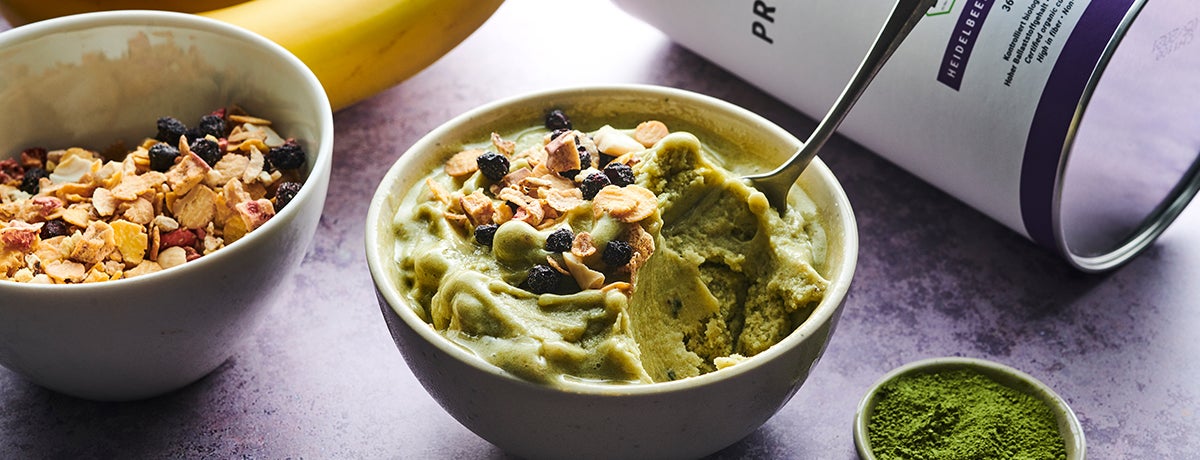
Start your nice cream adventure here
Kidney Bean Brownies
A classic chocolate dessert with fewer calories and a surprise ingredient you’d never expect! With only 150 calories per serving, our Kidney Bean Brownies may sound strange, but they taste delicious.
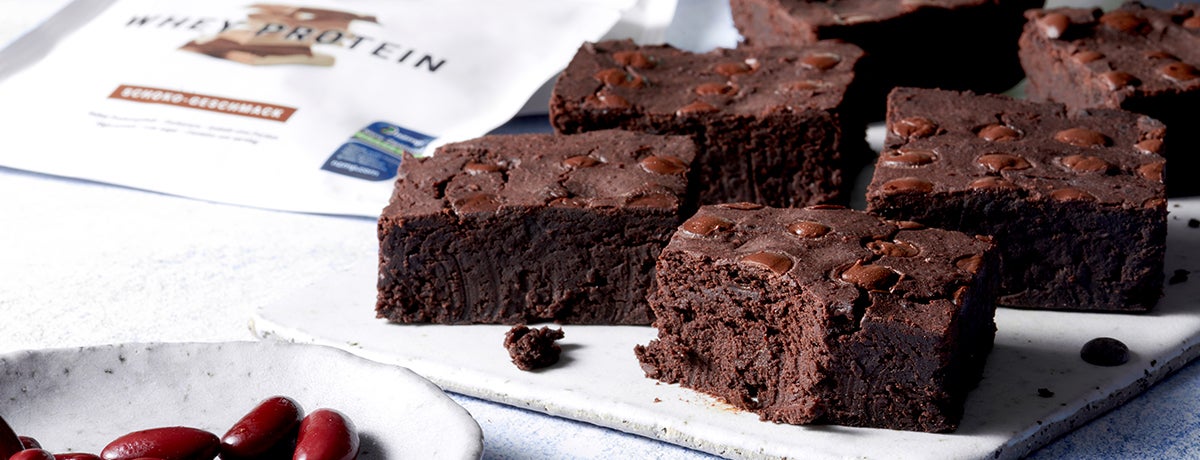
Is Eating That Much Protein Healthy?
No one can make progress toward their fitness goals without protein because they’re the basic building blocks of various elements of your body. Your brain, heart, muscles, bones, hormones, antibodies, and blood all need various amino acids to keep going.
The reference nutrient intake is 0.75 grams of protein per kilo of body weight. Depending on lifestyle and goal, you might want to aim for up to twice that. In the bodybuilding scene, you might even run into recommendations of 2 g. However, these high amounts also put additional stresses on your body.
Eating more protein than you need isn’t always a good idea. Metabolizing protein produces ammonia, which then has to be converted to urea in your kidneys. That always means more work for your kidneys so it’s also why you also need to drink enough if you’re following a high-protein nutrition plan.
If you have healthy kidneys, metabolizing protein isn’t usually a problem. However, there’s no reason to make your kidneys do extra work by eating too much protein only to immediately pee it out again.
Last but not least, if you eat so much protein that you end up consuming too many calories, you’ll add body fat and strain your digestion. All you’ll end up with is an unnecessary feeling of fullness, while falling short of your fitness goals.
Conclusion
- A high-protein diet means that you get a significant amount of your daily calories from protein.
- How much protein you should eat depends on your lifestyle and goals.
- Often we’re already eating more protein per day than we think. Analyze what you eat for a week to find out how much you’re really getting per day.
- Carbs are where you get most of your energy so they should always be part of your nutrition plan.
- Any excess protein you consume is processed by your kidneys. Don’t eat much more than you really need.
Sources for this article
We at foodspring use only high-quality sources, including peer-reviewed studies, to support the facts within our articles. Read our editorial policy to learn more about how we fact-check and keep our content accurate, reliable, and trustworthy.
- Verordnung (EU) Nr. 432/2012 https://eur-lex.europa.eu/legal-content/DE/TXT/?qid=1454323459180&uri=CELEX:32012R0432
- https://de.statista.com/statistik/daten/studie/208591/umfrage/eier-nahrungsverbrauch-pro-kopf-seit-2004/
- https://de.statista.com/statistik/daten/studie/5585/umfrage/pro-kopf-verbrauch-von-frischmilcherzeugnissen-seit-1999/
- https://de.statista.com/statistik/daten/studie/36573/umfrage/pro-kopf-verbrauch-von-fleisch-in-deutschland-seit-2000/
- https://de.statista.com/statistik/daten/studie/36573/umfrage/pro-kopf-verbrauch-von-fleisch-in-deutschland-seit-2000/




























